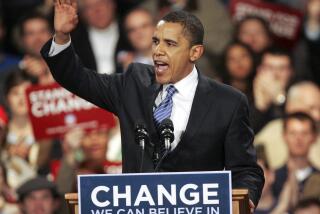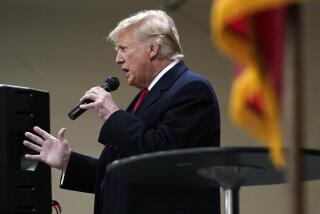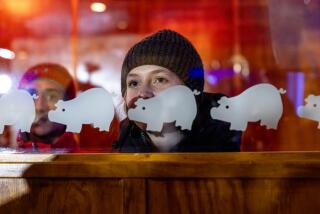Bernie Sanders tries to be the next Barack Obama in Iowa, not the next Howard Dean
Bernie Sanders delighted in telling a crowd of a couple of thousand people here this week about his journey from “fringe candidate” to serious contender for the Democratic presidential nomination, rattling off poll results reflecting his momentum and boasting that “the energy, the enthusiasm is with our campaign.”
But shortly before Sanders took stage, an organizer for his presidential campaign asked members of the crowd to raise their hands if they had signed up to volunteer. Only a few did.
“Oh, no. Not a lot of people here, I don’t think,” he said. “We need each and every one of you to rise to the occasion.”
It was a glimpse of Sanders’ toughest challenge as his sweeping call for a political revolution faces its first concrete test Monday in the Iowa caucuses. Their outcome will reveal whether the Sanders campaign operation, which has defied expectations with the enthusiasm it has drawn from disaffected liberals and college students, can harness that energy into votes the way Barack Obama did in 2008 when he beat the same establishment favorite Sanders now faces, Hillary Clinton.
Obama bested Clinton by motivating huge numbers of voters who normally wouldn’t participate in the caucus process to show up. Sanders himself is doubtful his campaign can reproduce the turnout Obama achieved, saying this week that the 2008 election “is really going to stay in the history books. It was an unbelievable campaign. In places they ran out of ballots, as I understand it.”
But he will be using a lot of the same organizational tools Obama did in claiming victory over a front-runner who seemed to have all the advantages in getting out the vote.
Targeting technologies pioneered by Obama’s campaign have made it possible for outsider candidates like Sanders to turn out Iowans who a decade ago might have showed up at a rally and then faded away before the caucuses. Now, computers can quickly link them up with a caucus coach who can walk them through the bewildering voting process and even make sure they have a ride on election night.
But ultimately, much of the work of sealing a commitment from voters happens through human contact. And to avoid the disappointment fellow Vermonter Howard Dean endured in the 2004 caucuses, when he failed to leverage similar insurgent momentum, the Sanders campaign has been rushing to build the infrastructure to capture enthusiasm and turn it into votes.
“The troops got beyond their supply lines,” Dave Nagle, a Democratic former congressman from Iowa, said of the Sanders operation. “Now they’re trying to catch up.”
Sanders has invested heavily in field offices, opening nearly two dozen in Iowa, just a few less than the much better-funded Clinton operation. The offices are a crucial hub for connecting with voters, and Obama opened an unprecedented 37 in Iowa in 2008.
Still, Sanders faces challenges unique to the organizational efforts this state demands. Nagle noted how his caller ID flashes with out-of-state area codes when Sanders volunteers reach out to him.
“God bless them that they’re here,” Nagle said. “But you want an Iowan talking to an Iowan.”
Another problem for Sanders is that everything he is doing, Clinton is also doing. Her campaign is determined not to be out-organized in Iowa again, and many of the strategists who set up Obama’s infrastructure are now working to elect her.
“Campaigns can target better and, thanks to a lot of rigorous experimentation, have a better sense of what actually gets potential voters to the polls,” said John Sides, coauthor of “The Gamble: Choice and Chance in the 2012 Presidential Election.” “But those tactics typically make a difference at the margins. So it’s an open question whether better campaign tactics will bring Sanders a victory, especially since Clinton is, of course, using the same tactics.”
By June, more than six months before the caucuses, Clinton’s campaign had identified a committed supporter in every corner of the state. Student volunteers have been plying their campuses since the fall to sew up commitments from classmates.
“She’s built relationships over a long period of time,” said Jeff Link, a Democratic strategist in Iowa who isn’t working for a presidential candidate this year. “She has a lot of key supporters around the state.”
The enthusiasm for Sanders, meanwhile, tends to be concentrated in a few parts of the state where there are big college campuses. That creates a challenge on caucus night, when the victor is decided by how many local precincts choose them, not the total number of votes they garner statewide.
It’s a big problem that did not affect Obama, even though his support was also concentrated in college towns. The caucuses were held in early January of 2008, when most students were home on break, so they voted all over the state.
Pete D’Alessandro, the Sanders campaign’s Iowa coordinator, said the concerns about geography are “a bit overblown.” Nonetheless, he wants help college students return to their hometowns to caucus, rather than just gathering on campus, to spread support as widely as possible.
“We’ve rented every van in a four-state area,” he said. “We want to be ready.”
The campaign has also sent organizers to speak in high school government classes, and Sanders sometimes meets with seniors before his events. Any student who will be 18 on election day in November is eligible to participate in the caucuses, and Sanders met with about 35 about them this month in Underwood, a town of about 900 people on the western edge of Iowa.
In such a small town, locking up support from young students “could change the outcome of that caucus,” D’Alessandro said.
Jordan Miller, an 18-year-old high school student from Sumner who went to hear Sanders speak on a college campus in Fayette in northeast Iowa, said he became a fan of the senator after watching the debates and researching his speeches on YouTube.
“I said, ‘This is the guy,’” Miller said. “Everything I support, he supports.”
Even in areas where Sanders and Clinton agree, such as fighting climate change, Miller said he finds the senator more credible.
“She’s like a robot,” he said. “Bernie talks with passion.”
It’s a pervasive view among young voters who have gravitated toward Sanders and his stark descriptions of the country’s political and economic inequality.
“He gets at the issue more. I feel like Hillary skirts around it,” said Hannah Will, 20, a nursing student at Luther College who has attended speeches from both candidates.
Sanders has served in Congress since 1991, and before that he was mayor of Burlington, Vt., for eight years. But supporters repeatedly said he feels less like a politician than Clinton.
“He just seems like a grandpa,” said Jacob Stock, 20, a social work student at Luther College. “It’s like you’re his grandkid and he’s taking care of you.”
Megerian reported from Decorah and Halper from Washington.
Twitter: @chrismegerian, @evanhalper
ALSO:
How Martin O’Malley could decide who wins the Democratic caucuses in Iowa
Republican rivals take advantage of Trump’s absence in Iowa presidential debate
Trump makes a big show of skipping GOP debate and staging benefit for veterans
More to Read
Get the L.A. Times Politics newsletter
Deeply reported insights into legislation, politics and policy from Sacramento, Washington and beyond. In your inbox three times per week.
You may occasionally receive promotional content from the Los Angeles Times.








